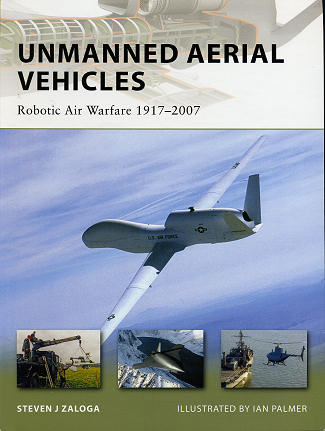 #144 in
Osprey's New Vanguard series covers the history to date of Unmanned Aerial
Vehicles (drones). First envisioned in WWI as a way to carry torpedoes, those
early attempts were stymied by a lack of technical capabilities, something that
happens often with newly thought projects.
#144 in
Osprey's New Vanguard series covers the history to date of Unmanned Aerial
Vehicles (drones). First envisioned in WWI as a way to carry torpedoes, those
early attempts were stymied by a lack of technical capabilities, something that
happens often with newly thought projects.
However, it was seen that these vehicles could be programmed
prior to flight and were found to be quite useful as targets for gunners. During
WWII, it was seen that these vehicles could be used to carry bombs and be
remotely controlled by a parent aircraft to a target. The US Navy used one of
its fleet of TDN-1s to attack several Japanese targets in the closing year of
the war. In Korea, bomb laden remotely controlled Hellcats were used with some
success against North Korean fixed structures.
It was Vietnam and the use if Ryan jet powered drones to
perform photo reconnaissance where the UAV first found widespread acceptance as
a way to get the job done in high threat areas. Some were even equipped with
bombs and used to drop these on targets, though the results were not as
expected.
It is in reconnaissance that drones found a niche. The
Soviets developed intercontinental range drones; huge vehicles that are designed
to fly thousands of miles on their missions. In the US, the supersonic D-21
drone, carried by B-52s was developed, but with minimal success, mostly due to
an inability to retrieve the film. Satellites took over that mission.
Today, there is a lot of research and effort going into
UCAVs. The C is for combat and modern drones, flown from remote locations have
been successful in staying aloft for days until needed, then firing off their
ordinance (such as Maverick air to surface munitions) before returning to a
distant base. These long range vehicles are not inexpensive and as costly as a
manned vehicle. Yet they are very much a thing of the future, able to provide a
goodly number of missions from strategic to tactical use with some as large as
an F-15 and others small enough to be carried by a man.
Author Zaloga along with some superb photographs and the
illustrations of Ian Palmer, tells the story of these vehicles from their
earliest inception to the current range of vehicles to those being developed for
the future. A story that has really just begun and is as fascinating today as it
was when first developed. A book I know you will find interesting and
informative. Highly recommended along with all of Osprey's titles in this
series.
October 2008
For more on the complete line of Osprey books,
visit www.ospreypublishing.com. In the US, it is
Osprey Direct at 44-02 23rd St, Suite 219, Long Island City, NY 11101., where you can
get a catalogue of available books.
If you would like your product reviewed fairly and quickly by a
site that has over 350,000 visitors a month, please contact
me or see other details in the Note to
Contributors.
 #144 in
Osprey's New Vanguard series covers the history to date of Unmanned Aerial
Vehicles (drones). First envisioned in WWI as a way to carry torpedoes, those
early attempts were stymied by a lack of technical capabilities, something that
happens often with newly thought projects.
#144 in
Osprey's New Vanguard series covers the history to date of Unmanned Aerial
Vehicles (drones). First envisioned in WWI as a way to carry torpedoes, those
early attempts were stymied by a lack of technical capabilities, something that
happens often with newly thought projects.